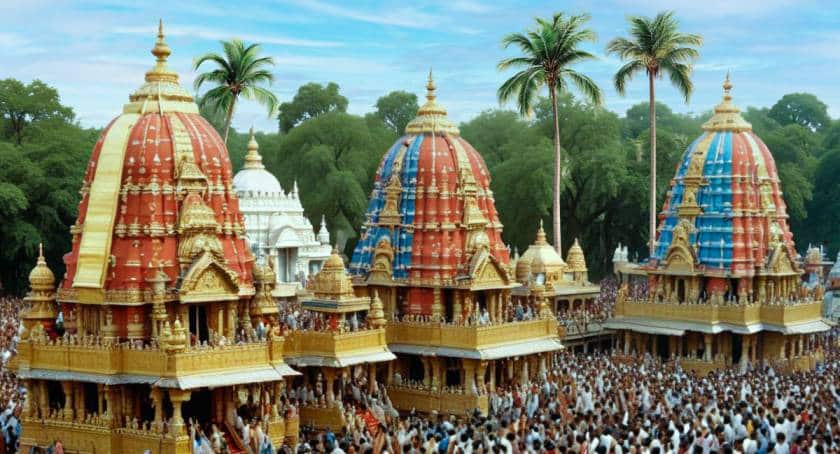Ratha Saptami- Hindu festival
Ratha Saptami is a sacred Hindu festival dedicated to Lord Surya, the eternal source of energy and life. It is celebrated on the seventh day (Saptami) of the bright fortnight (Shukla Paksha) in Magha and signifies the Sun God’s symbolic journey across the celestial sphere. Indians revere this festival, but the people of Odisha hold it in special regard, blending spiritual significance with unique regional traditions.
Odisha, known for its rich cultural legacy and devotion to deities, sees grand rituals and temple ceremonies honoring Surya Bhagwan during Ratha Saptami. Devotees gather at historic temples, such as the renowned Konark Sun Temple, to offer prayers, perform Surya Namaskar, and embrace the spiritual essence of this auspicious occasion. The festival marks a divine celebration and resonates with astronomical and seasonal transitions, symbolizing renewal and positivity.
The Mythological Origins and Significance of Ratha Saptami
According to Hindu mythology, Ratha Saptami honors the birth of Surya Bhagwan and marks the beginning of his divine journey across the heavens. Devotees hold that the Sun God began his heavenly journey on this day in a wheeled vehicle pulled by seven horses, which stand in for the seven colors of light and the seven days of the week.
The charioteer, Aruna, symbolizes the dawn, leading the Sun God on a journey that signifies the change of seasons and the flow of time. Devotees celebrate this divine movement as a harbinger of new beginnings, prosperity, and enlightenment. Thus, Ratha Saptami is considered an auspicious time to seek divine blessings for health, wisdom, and spiritual growth.
Grand Festivities and Sacred Traditions of Ratha Saptami
With its deep-rooted traditions, Odisha celebrates Ratha Saptami with magnificence and devotion. Devotees rise early for the ceremonies, which start at daybreak, and bathe in sacred ponds or rivers, believing that the water purifies the body and soul. Devotees perform Surya Namaskar, a set of 12 yoga postures dedicated to the Sun God, while chanting Vedic hymns to invoke divine blessings.
Temples dedicated to Surya Bhagwan, including the world-famous Konark Sun Temple, Jagannath Temple in Puri, and other sacred shrines across Odisha, witness thousands of devotees participating in the festivities. The rituals and offerings made on this day reflect Odisha’s spiritual essence and cultural vibrancy.
- The Grand Celebrations at Konark Sun Temple
The main attraction of Odisha’s Ratha Saptami celebrations is the Konark Sun Temple, a UNESCO World Heritage Site. King Narasimhadeva I of the Eastern Ganga Dynasty built this architectural marvel in the 13th century, dedicating it to Surya Bhagwan and designing it to resemble his celestial chariot.
During Ratha Saptami, thousands of devotees and tourists visit the temple to witness the grandeur of the celebrations. Devotees conduct special rituals, cultural performances, and spiritual discourses, emphasizing the significance of the Sun God in Hindu philosophy. The temple’s sculptures and carvings come alive with the devotion of worshippers, creating an atmosphere of divine energy and reverence.
- Sacred Rituals and Devotional Offerings for Surya Bhagwan
Devotees across Odisha perform the rituals of Ratha Saptami with great devotion, embracing their deep symbolic significance. Some of the key observances include:
- Arghya Daan: Devotees offer water to the rising Sun while chanting sacred mantras, seeking health, prosperity, and spiritual purification.
- Surya Namaskar: Devotees perform the 12-step Sun Salutation as an act of gratitude and devotion.
- Til Daan: Offerings of sesame seeds, jaggery, and food are made to needy people, symbolizing warmth and compassion.
- Rangoli Art: Devotees draw complex chariot-shaped rangoli designs at the entrance of their homes, representing Surya Bhagwan’s celestial journey.
- Jagannath Temple in Puri and the Divine Surya Puja
The Jagannath Temple in Puri, one of the Char Dham pilgrimage sites, also observes Ratha Saptami with special rituals. Lord Jagannath is considered an incarnation of Surya Bhagwan, and this festival holds deep significance in Puri’s religious traditions.
On this auspicious day, devotees offer special bhogs and prayers to the deity, while temple priests perform Surya Arghya in honor of the Sun God. Devotees gather large numbers, carrying sacred lamps in processions around the temple premises, creating an ethereal sight of devotion and celebration.
The Spiritual and Scientific Aspects of Ratha Saptami
Ratha Saptami is a religious observance and holds scientific and health-related importance.
- Astronomical Significance: The festival celebrates the Sun’s movement towards the northern hemisphere, known as Uttarayan, which Hindus consider an auspicious time.
- Health Benefits: Sun worship and Surya Namaskar performed on this day enhance vitality, boost immunity, and improve digestion.
- Spiritual Awakening: People believe that offering prayers to the Sun God cleanses the mind and soul, bringing positivity and enlightenment.
Traditional Cuisine and Sacred Offerings of Ratha Saptami
Festivals in Odisha are incomplete without their delectable traditional cuisine. Some of the unique dishes prepared on Ratha Saptami include:
- Khechudi (Khichdi): A wholesome dish made of rice, lentils, and spices, offered as prasad.
- Chhena Poda: Odisha’s famous baked cottage cheese sweet is a delectable offering to the deities.
- Pakhala Bhata: Fermented rice served with curd and vegetables, a cooling and nutritious meal.
- Til Laddoo: Made of sesame seeds and jaggery, symbolizing warmth and prosperity.
Final Thoughts
Ratha Saptami in Odisha is more than just a festival; it celebrates cosmic energy, seasonal change, and spiritual renewal. This festival’s rituals, traditions, and cultural vibrancy make it a unique experience for devotees and visitors alike. As the Sun God rides his celestial chariot, let us embrace the divine light, seeking wisdom, health, and prosperity in our lives.
May the blessings of Surya Bhagwan shine upon all!


